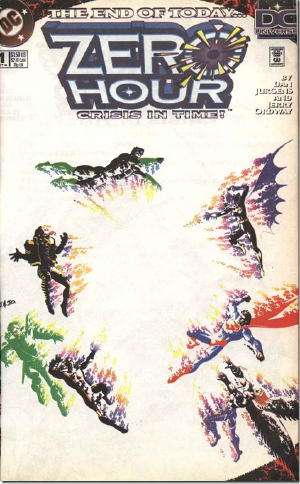Zero Hour

The 1994 sequel to Crisis on Infinite Earths and second of the many reality-warping Crisis Crossovers to hit The DCU. Written and illustrated by Dan Jurgens, with inks by Jerry Ordway.
Just as Crisis removed The Multiverse from the DCU, Zero Hour: Crisis in Time was intended to fix the many confusing alternate timelines that had cropped up over the previous decade. And also like Crisis, Zero Hour failed, making everything involved--Supergirl, Hawkman, The Legion of Super-Heroes--even more confusing. Zero Hour was unique in that it started with issue #4 and worked its way back to #0; to coincide with the final issue, every ongoing DC series published a special "Issue Zero".
The plot of Zero Hour begins with the apparent death of the Legion's nemesis, the Time Trapper, at the hands of an unknown assailant at the end of time. After this event, the future history of Earth gets wiped out "in reverse", eventually including the Legion's 30th century home. Meanwhile, the past is also getting wiped out, with walls of entropy converging on the present. (How any of this is possible is an exercise left to the reader.)
At first, the villain of the piece appears to be Extant, formerly the hero known as Hawk, who had been the Big Bad of an earlier Crisis Crossover, Armageddon 2001. However, it turns out that Extant was actually working on the orders of none other than the former Green Lantern Hal Jordan, aka Parallax, who had gone mad with grief after the destruction of his home of Coast City. Parallax wanted to remake the universe in his image to prevent Coast City's destruction and other tragedies. His former comrades, deciding that a better universe isn't worth the destruction of the old one, fight Parallax and defeat him, triggering a new Big Bang and restoring the timeline--with a few differences.
Unlike its predecessor, Zero Hour met with poor reception, largely due to its lackluster execution. Plot points were thrown in with no build-up, some important events occured in tie-in issues rather than the main story itself, and the whole thing was mired in the Dark Age of Nineties Anti Heroes. The story's saving grace was the conflict surrounding Hal Jordan's actions and the heroes' response to seeing their friend become a villain, but that occurred almost entirely in the final issue and wasn't enough to salvage it.
Zero Hour resulted in a few significant changes to The DCU, most notably the introduction of the "post-boot" Legion of Super-Heroes. It also spawned a few Spin-Off series, ranging from the awful Fate and Manhunter, to the aggressively mediocre Primal Force and Xenobrood, to the critically-acclaimed and long-running Starman.
In the end, Zero Hour hasn't been forgotten by DC--it remains in continuity, or at least it did until the New 52 --but its events have been swept under the rug and mostly reversed. The problems it introduced were among the factors that led to the next Cosmic Retcon of The DCU and the first "proper" sequel to Crisis on Infinite Earths, 2005's Infinite Crisis.
No relation to the airline disaster movie on which Airplane! is based, the German dub title of Future War 198X, the expansion pack of Command & Conquer: Generals, or the third After Hours season of I'm a Marvel And I'm a DC.
- Advancing Wall of Doom: The entropy rifts.
- Big Bad: Parallax.
- Blow Gun: In one Batman storyline, The Joker frames Batman for the Penguin's murder by having a henchman shoot a poison dart this way, thus making it appear as if Batman knocked Penguin off a side railing with his Batarang and made the villain fall to his death.
- Canon Discontinuity: The subplot about Power Girl giving birth seems to have been dropped from continuity.
- Cosmic Retcon
- Curb Stomp Battle: Extant vs. the Justice Society of America. The JSA didn't stand a chance.
- The Dragon: Extant.
- Fallen Hero: Extant and Parallax.
- Heroic BSOD: Green Arrow breaks down in grief after the fight with Parallax.
- Minimalistic Cover Art: Issue #0.
- My Hero Zero
- The Man Behind the Man: Parallax.
- Rapid Aging: Extant used his powers to age most of the Justice Society members to their proper physical ages, some even to their deaths.
- Set Right What Once Went Wrong/Utopia Justifies the Means: Parallax's ultimate goal, from preventing the Coast City tragedy, restoring the Green Lantern Corps, and was about to restore the Pre-Crisis Multiverse (or at least it was implied).
- Superpower Meltdown: Damage in the final battle.
- Unusual Chapter Numbers: The first issue is numbered 4 and counts down to issue 0.
- Well-Intentioned Extremist / Woobie, Destroyer of Worlds: Parallax.
- What Could Have Been: Years after Zero Hour had been finished, Alex Ross proposed a limited series entitled Batboy. Based off the Super-Sons imaginary story from the 1970s, Batboy featured an idealistic future of the DCU, with Batboy and his best friend Superman Jr. as the main characters. The original JLA would've been retired, with the Teen Titans now comprising the League. Other heroes would be Batwoman (Barbara Gordon) and Superwoman (Kara Zor-El), Barry Allen's kids the Tornado Twins, and Aquaman's still-living son, Arthur Jr.. The Joker would still be active, only with a teenage daughter by his side. Harvey Dent would've been cured of his psychosis and acting as a tutor for Bruce Jr., who would have a baby sister named Helena. The only still active member of the original League would've been Hal Jordan. How this ties into Zero Hour is that Batboy would've realized this world seemed too ideal, and would discover that, this was the end result of Hal's attempt to remake the DCU, and would confront him on it. Character designs and plot information for this series were released in Ross's art book Rough Justice.